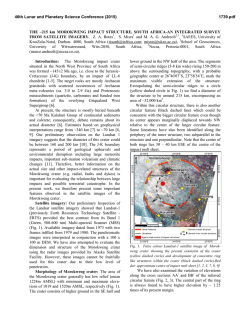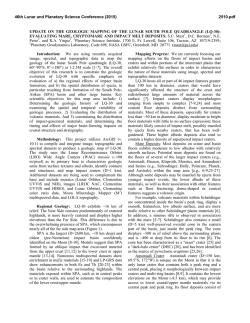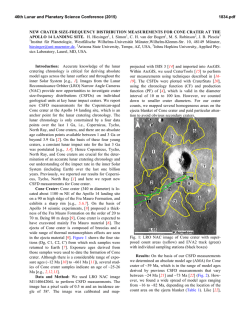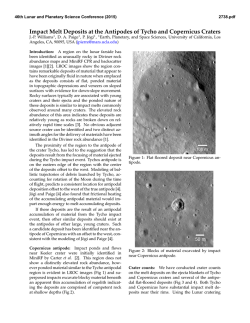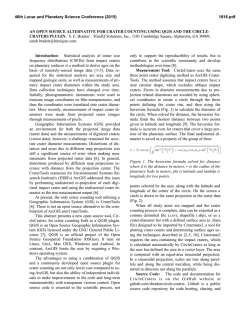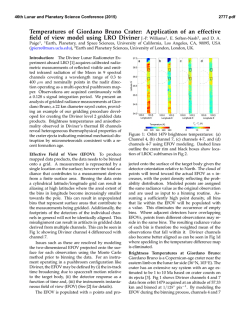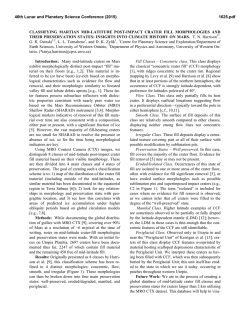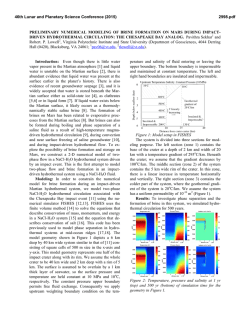
BRIGHTNESS TEMPERATURE OVER CRATER TYCHO
46th Lunar and Planetary Science Conference (2015) 1302.pdf BRIGHTNESS TEMPERATURE OVER CRATER TYCHO : OBSERVATION AND SIMULATION G. P. Hu1,2 ,Y. C. Zheng1,2,3*, A.A. Xu1,2, Z.S.Tang1,2 1 Space Science Institute, Macau University of Science and Technology, Avenida Wai Long, Taipa, Macau 2 Lunar Planetary Science Laboratory, Macau University of Science and Technology, Partner Laboratory of Lunar and Deep Space Exploration, Chinese Academy of Sciences Avenida Wai Long, Taipa, Macau 3 Key Laboratory of Lunar and Deep Space Exploration, National Astronomical Observatories, Chinese Academy of Sciences, Beijing 100012, China * Email: [email protected] diurnal difference over a crater; TBnight (K) is the nighttime observation and TBday (K) is the daytime observation from CE-1. Here the rock abundance is the retrieved results from Diviner Lunar Radiometer Experiment data[6]. The curve shape of the diurnal TB difference and the average lunar rock profile display general similarities over the crater. diunarl TB difference(K) 60 S(%) 5 RA content TB differcence 0 -46 -45 -44 -43 -42 latitude(°) of observation dot over crater Tycho -41 40 Fig. 1. Correlation between diurnal TB difference and rock abundance over crater Tycho. Relation between Diurnal TB Difference and Atitude Profile:The curve shape of the diurnal TB difference and the altitude profile display general similarities over the crater, especially over regions inside the crater. The altitude H is gotten by the formula H = h-1737000 (m), where h (m) is from level 2B LAM data. -40 2000 0 -50 altitude (m) diunarl TB difference(K) Introduction: Multichannel (3.0-, 7.8-, 19.35-, and 37-GHz) microwave radiometer (MRM) was aboard Chang’E-1 (CE-1) and (CE-2) lunar exploration t, for measuring the brightness temperature (TB) from the lunar surface, surveying the global distribution of lunar regolith thickness, and globally evaluating 3He content[1],[2]. The first global TB map of the moon[3] was obtained from CE-1’s MRM, refelcting lunar topographic signatures in the 37GHz TB maps, such as the boundaries between mare and highland, and the contour of craters. Some New features of crater Tycho from TB data are shown in a single track view. Data set observed by CE: The observed data applied here are level 2C microwave radiometer(MRM) data, level 2C Charge Coupled Device (CCD) stereo camera data, and level 2B laser altimeter (LAM) data from CE-1 lunar orbiter, which comply with Planetary Data System (PDS) standards for file formats and directory names, and are now publicly available: http://159.226.88.59:7779/CE1OutENGWeb/ce1files.j sp.The CE-1 MRM was calibrated onboard periodically (the calibration performs every 11.6s, i.e., once every MRM measurement cycle) to assure its reliability and accuracy, using a two-point calibration method[4]. The nonlinearly error of the calibration is within 1K at 37-GHz channel[4]. Detail description about data calibration and data quality can be found in the relevant literatures[3],[4],[5]. The definition of MRM data at various levels of preprocessing was described before[3], and the definition of CCD camera and LAM data at various levels of preprocessing is similar to that of MRM data. 2763 tracks (orbit number from 0243 to 3005) of MRM data by CE-1 from November 2007 to July 2008 are collected. Relation between Diurnal TB Difference and Rock Abundance: Due to the large rock abundance preserved in the young craters[4], diurnal TB difference over crater Tycho (43.31°S 11.36°W) have been chosen to compared with their altitude profile. The diurnal TB difference is defined as ∆TB = TBnight − TBday , where ∆TB (K) stands for the -2000 -60 TB differcence altitude -46 -45 -44 -43 -42 latitude(°) of observation dot over crater Tycho -41 -4000 Fig. 2. Correlation between diurnal TB difference and altitude profile over crater Tycho. Simulation of Microwave Brightness Temperature over Lunar Surface:A detailed method(Fig.3) to 46th Lunar and Planetary Science Conference (2015) 1302.pdf compute brightness temperature (TB) over a lunar crater is proposed, which incorporated the effect of surface tilts. The method improves the effective solar irradiance(ESI) model(Eq.1) of the lunar surface to obtain the temperature profile of the lunar crater [7].The simulated behavior of TB across craters reproduces the TB undulation observed by CE in a single swath. The biggest difference between simulation and observation happens at the central peak of crater Tycho. And this may be casued by the unconsidered fragment rock. Here the DEM data are the LOLA reduced data record (RDR) [8]. (1) Fig. 3. Microwave radiation transfer model for lunar crater surface. Fig. 4. Comparison between simulated and observed TB over crater Tycho. Interpretation of TB Variation over Lunar crater:TB is the averaged radiometry of lunar surface within a spatial resolution weighting with the MRM antenna radiation pattern[4]. With the smaller penetra- tion, the value of 37GHz TB along the profile of a crater is determined by the average temperature within a spatial resolution, i.e., the percentage of the cold and warm areas, due to the effect of shadow and surface tilts. As MRM scanning across the crater, the percentage of cold and warm areas inside a spatial resolution varies, and TB shows an oscillatory behavior[7][9]. TB variation over a crater is proved to be significantly affected, through physical temperature, by the crater shape described by DEM. The amplitude of the TB oscillatory curves depends on the crater shape[7][9]. Discussion: Seen from the TB observation of crater Tycho, the rock abudance is correlated with the crater shape described by the DEM from LOLA. The fact that the whole trend of simulated TB at 37GHz over crater Tycho without rock abundance is consistent with that of the observation, may prove that the crater shape determined the TB distribution. Thus, the crater shape may determined the rock concentration. References: [1] Ouyang Z.Y. et al. (2010) CJSS, 30(5), 392-403.[2] Zheng Y.C. et al. (2008) PSS. 56(7), 881-886. [3] Zheng Y.C. et al. (2012) Icarus, 219, 194-210.[4] Wang Z.Z. et al.(2010) Sci. China Ser. D Sci., 53(9), 1392-1406. [5] Chan K.L.et al.(2010) EPSL.295, 287-291.[6] Bandfield J.L. (2011) JGR, 116, E00H02.[7] Hu G.P. et al. (2014) IEEE TGRS 52(8), 4499 - 4510. [8] Smith D. E. et al. (2010) Space Sci. Rev., 150, 209-241. [9] Hu G.P. et al. (2013) JARS 7(1), doi:10.1117/1.JRS.7.073469. Acknowledgments: This work were jointly supported by grants from the Science and Technology Development Fund of Macau (048/2012/A2 and 020/2014/A1) and NSFC program (41490633).
© Copyright 2026

